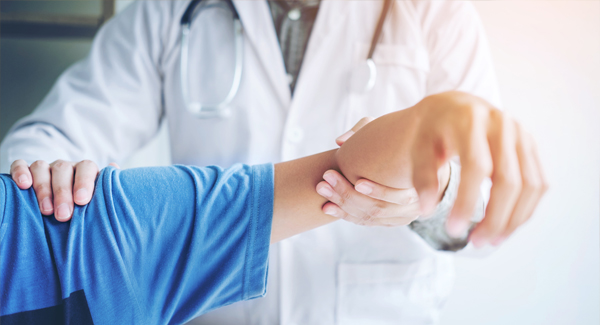Protect Your Bone Health
Take steps early to prevent osteoporosis, especially if you’re at risk.
By Linda Rath | March 23, 2022
Age and corticosteroids like prednisone can make your bones thinner, weaker and more prone to fractures. So even if your bones are in great shape now, you may worry about a hunched back or broken hip later in life.
Two of the nation’s leading osteoporosis experts say not to worry: A healthy lifestyle, including regular weight-bearing exercise and calcium and vitamin D supplements, can strengthen bones and help prevent fractures.
Who’s at Risk?
Your body is constantly losing and rebuilding bone mass, and osteoporosis occurs when you lose bone faster than your body can replace it. While this becomes more common as you age, it is rare in younger adults, according to Kenneth Saag, MD, professor of medicine and director of the Comprehensive Arthritis, Musculoskeletal, Bone, and Autoimmunity Center at the University of Alabama, Birmingham.
“Fracture risk is much lower in premenopausal people, even if they have very low bone mineral density, because they have more estrogen and muscle strength and fewer falls,” he says. “An 80-year-old is substantially more likely to have a fracture than a 50-year-old. Age is a better predictor of facture than bone mineral density.”
Dr. Saag believes bone mineral density (BMD) is an unreliable predictor of bone health in general. And he’s no fan of the dual-energy X-ray absorptiometry (DXA) scans commonly used to measure it. He points out that the two-dimensional scans don’t capture the thickness and volume of bone, and they often underestimate BMD in smaller-boned people and those on prednisone.
A better way to diagnose osteoporosis, he says, is through the presence of low-trauma or fragility fractures, especially in the pelvis and spine. These fractures, which occur with minimal or no impact, are often due to factors other than normal human aging. Called secondary causes, they include:
- Rheumatoid arthritis or lupus
- Prednisone, the most common cause of medication-induced bone loss, affecting about 30% of people, even at very low doses for short periods of time
- Low estrogen due to thyroid problems, diabetes or eating disorders
- Gastrointestinal disorders like celiac disease, inflammatory bowel disease, lactose intolerance and malabsorption
- Vitamin D deficiency
- Pregnancy
By some estimates, up to half of the cases of osteoporosis are due to a secondary cause, which often goes undiagnosed. Yet managing secondary causes is critical to improving bone health.
To Treat or Not?
Dr. Saag says drugs aren’t needed or recommended for treating low bone density in younger people unless there’s a history of low-trauma fractures or very low bone density and ongoing bone loss despite conservative treatment.
Instead, he prescribes bone-building exercises, like walking, hiking, jogging, dancing, stair-climbing and weight training, along with an optimal diet and calcium and vitamin D supplements. Although dosages vary by age and gender, standard recommendations range from 1,000 to 1,200 mg calcium and 600 to 800 IU vitamin D. If you have low bone density as a result of vitamin D deficiency (your doctor can test for this), you may need much higher amounts — up to 50,000 IU once or twice a week. The goal is for your test results to reach what’s called a 25-hydroxy vitamin D blood level of 35 to 45 nanograms per milliliter (ng/mL).
Preventing Osteoporosis as You Age
Bones are typically at “peak bone health” — the strongest and most dense — at around age 20 or 30. For most healthy people who don’t take corticosteroids, bones stay in tip-top shape for decades. Bone loss starts in earnest when women hit menopause and bone-protective estrogen levels plummet. Men experience a slower but steady decline in bone health beginning at about age 40.
Yet age-related osteoporosis isn’t inevitable, according to Nancy Lane, MD, an endowed professor of medicine, rheumatology and aging research at the University of California, Davis, and an internationally recognized expert on osteoporosis and osteoarthritis.
Dr. Lane says the chance of late-life osteoporosis depends a lot on the peak bone health you achieved earlier. The greater your bone mass to begin with, the more reserves you have when it starts to decline. Genetic factors determine peak bone health for the most part, but getting plenty of exercise and taking calcium and vitamin D supplements when you’re young can strengthen bones so there’s more in the “bone bank” as you age.
Why Supplements?
Vitamin D works in tandem with calcium to increase the amount of calcium you absorb from food and prevent calcium loss through your kidneys. With adequate vitamin D, you absorb 30% to 40% of dietary calcium; when vitamin D levels are low, you may absorb just 10% to 15%. Drugs like prednisone counter the positive effects of vitamin D, preventing calcium absorption and increasing the amount lost through your kidneys.
Although we produce most vitamin D in our skin when it’s exposed to sunlight, people who don’t get much sun exposure may not produce enough this way. And few foods are naturally rich in vitamin D; the best sources are salmon, fish oils and some mushrooms. Vitamin D is also added to “fortified” foods, including orange juice and cereal, but in relatively small amounts, so most people don’t get enough from food. A National Institutes of Health study found that older women got about 140 IU a day, though the recommended minimum amount – which many experts think is too low – is 800 IU.
The best way for most people to get enough vitamin D is through supplements, says Dr. Lane, who recommends 1,000 IU to 2,000 IU of vitamin D3 to her patients.
Calcium can be problematic, too. It’s found in many foods, including dairy products, canned fish and leafy greens, but it’s hard for your body to metabolize. Labels indicate how much calcium a food contains, not how much you absorb — or how much is “bioavailable” — which is often surprisingly low.
For example, you probably absorb about one-third of the calcium in milk and cheese. Most leafy greens have less calcium but 50% bioavailability. In terms of calcium, a cup of bok choy beats a glass of milk. Also, foods that contain oxalic acid interferes with calcium absorption. Surprisingly, these include spinach, nuts, legumes and soy milk. Dr. Lane recommends supplements for most older adults, especially citrate and carbonate forms, which are more easily absorbed.
“Calcium and vitamin D are incredible for bone health,” she says. "A healthy diet and supplements are necessary in most patients. Even for people with severe osteoporosis, normal supplementation should be enough.”
She also debunks the notion that calcium supplements increase the chance of heart problems. She points to a clinical guideline from the Bone Health & Osteoporosis Foundation and American Society for Preventive Cardiology that found no increased risk of cardiovascular disease with calcium supplementation. There is a small risk of kidney stones, she says, but “calcium supplements do not result in calcification of blood vessels.”

Stay in the Know. Live in the Yes.
Get involved with the arthritis community. Tell us a little about yourself and, based on your interests, you’ll receive emails packed with the latest information and resources to live your best life and connect with others.


